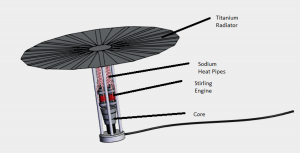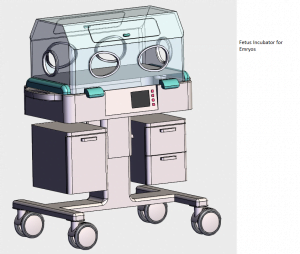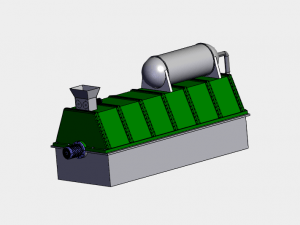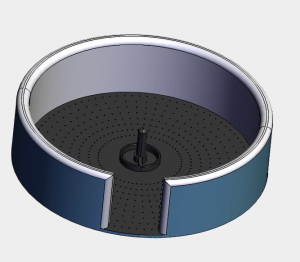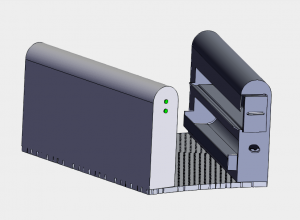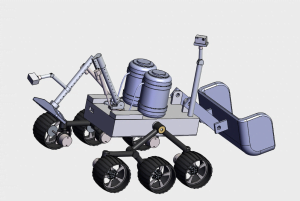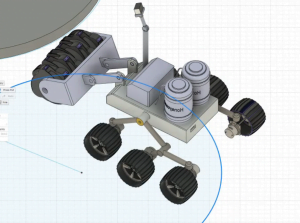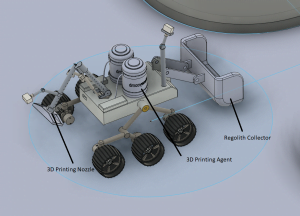Moon Camp Pioneers Gallery 2020-2021
In Moon Camp Pioneers each team’s mission is to 3D design a complete Moon Camp using Fusion 360. They also have to explain how they will use local resources, protect astronauts from the dangerous of space and describe the living and working facilities.
Team: AstroACI
American Collegiate Institute Izmir Turkey 15, 16, 17
External viewer for 3d project
|
Project description
The main mission of our Moon Camp project is to create a self-sustainable environment on the Moon that is able to act both as a research center, and an intermediary launch site for other extraterrestrial missions. Our project consists of stages. In the first stage, we will be focusing on creating a small environment for astronauts to survive and construct the required systems with remotely controlled equipment. Nuclear reactors will be placed inside the nearby crater, and a 3D printer rover will be set up in order to enable construction. Bare minimum requirements such as oxygen/water/food/energy production and a living place for astronauts to arrive will be attained. The bigger main hub, a life support system, and living quarters will be added/constructed along with additional materials such as a nitrogen tank for the arrival of the astronauts. Afterwards, the Second Stage will start. This stage’s focus will be to construct the other important components necessary to the function of the camp. Since an environment was already arranged in the First Stage, the first astronauts will be brought to control the setup of bedroom, botanic, and husbandry. The first small experiments and projects will get started. The next step will be the Third Stage, which will mainly focus on expansion and reinforcement of the base. For instance, other components will be added, and transportation vehicles will be brought, the roof of the main hub will be strengthened with extracted titanium, and a launchpad will be built. |
|||
|
Where do you want to build your Moon Camp?
We want to build our base in the equatorial region, between the Apollo 14 and Apollo 12 landing sites (lat:-1.92, lon:-23.4). There are many reasons behind our decision. First, the abundance of elements Ti, H3, H, and Fe would help build structures and help resource management. Second, solar radiation and moonquake rates are lower, hence the lifetime of the base would be greater. Third, transportation between the Earth, Moon, and beyond would be much quicker and easier compared to the poles because the gravitational pull would be less. Fourth, since the seismic measurements in those regions were previously made comprehensively thanks to the Apollo 12 and 14 Missions, the structure would be set on a solid basis. Lastly, we noticed that psychology can sometimes be overlooked in technical projects. Making the base in the equatorial region would contribute to astronauts’ morale with its breathtaking Earth view. How do you plan to build your Moon Camp? Describe the techniques and materials you would use.
Our design will be based on a hexagonal structure that looks like a honeycomb shape. Some of the reasons why we chose to arrange our modules in a hexagonal shape is that in a hexagonal grid each line is as short as it can possibly be if a large area is to be filled with the fewest number of hexagons or other geometrical shapes, and hexagonal shape is one of the strongest structure in nature. That’s one of the reasons why bees use hexagons in their beehive. Hexagonal design is also beneficial for its unique organization opportunities, 6 different and equidistant corners from the center for modules. The expandability of this design is another advantage. So, as the colony grows, symmetric and neat expansion will be possible. Our modules, optimally, are closely similar to Igloos. Igloo modules have a circular form which creates a Faraday Cage. Thus, it provides the advantage of shielding electrical circuits. Additionally, every igloo module will contain small hexagonal holes on the ceiling which will collect photons and use sunlight for the lighting of the colony on sunny days. The concave-shaped glass shield will be preventing the gamma and x-rays from getting inside and collecting 450-760 Nm waves into the center. If we take a look at the layers of wall which separate the camp from space, the placement of the layers are in the order of: internal scuff barrier, redundant bladders, kevlar restraint layer, and the external shell which is made of 3D printed regolith. The environment on the Moon is very dangerous for the astronauts. Explain how your Moon Camp will protect them.
One external danger can be asteroid/meteor strikes. To be prepared for them, we must know where they were going to hit from. In a research, that we have made, concerning the dimensions of 28 craters near our base location (https://docs.google.com/spreadsheets/d/1X8LtUiE-8PiYrjb2in_Q5fpt0OCZN_zeHwBFdxhZddI/edit?usp=sharing) we saw that the slope difference of the sides of craters are really small in the equatorial region. Therefore, the vertex of the doms need to be the strongest, and making them out of gathered regolith combined with integrated 3d printed bird bone structure, would be advantageous. Another threat would be lunar dust. To overcome this threat we will have a washing system to clear the suits and equipment of dust, and a perfectly preventive exit system. Lastly, to protect from radiation we will use lead in the outer shell that is planned to be built in the Third Stage. Explain how your Moon Camp will provide the astronauts with:
|
|||
|
Water
|
Food
|
Electricity
|
Air
|
|
Our Moon Camp will utilize the regolith as a source of hydrogen to produce water. We will gather regolith which contains 50-75 ppm of Hydrogen. The regolith will then be heated until outgassing occurs. Afterwards, the harvested hydrogen from regolith will be utilized by combusting it with oxygen, this also powers our in-vessel composting system that recycles the biological waste created by the base. This method of course has its woes, and the main one is the inefficiency of the methodology. In order to compensate for that, we are utilizing a water reclamation system quite similar to ISS. This system allows us to reclaim a quite large amount of the water, between 70 and 85 percent, of the water used for the crew’s life support. |
We set a daily calorie sum of 2700 kcal for the astronauts. 500 of this will come from 3 eggs, 1000 kcal from potato, and 1200 kcal from broccoli. Broccoli will also satisfy the vitamin and folic acid needs. Astronauts will set up a hydroponic system to grow the greenery. In the case of husbandry, astronauts will satisfy their needs for protein and fat from pig and chicken meats and eggs. First, a set of these animals can be brought normally, but after the Second Stage, the animals will be brought as embryos. They will be grown in artificial wombs, in incubators that are located in labs, later to be transported to the husbandry module for a more natural growth. This will lower the cost of transportation, and also contribute to science. In case of any emergency, canned food and additional water will be stored additionally. |
A nuclear fission reactor will be utilized to power the base. The reactor will use high-enriched uranium as fuel and heat pipes filled with liquid sodium(able to flow freely between 400 and 700 °C) will be used as a coolant. The heat carried out through the heat pipes will be transferred to the Stirling converters situated above the core. Above the Stirling engines is the titanium water radiator. This end provides the cold necessary for the Stirling engines to run. Stirling engines linear electric generators to produce electricity. A 10kwe reactor, in the beginning, will be deployed to power the unmanned rovers, drones, and such, later to supply other modules inhabited by a crew of 3 people 30-40kwe is the goal. Assuming the volume and the weight of a reactor multiple deliveries will probably be required to meet the requirements of the base. |
Air consists of 78% nitrogen and 21% oxygen. Nitrogen is first needed to be brought from the Earth, but if our research about the nitrogen composition gives success additional ways can be considered. We will use the ISS ECLSS to electrolyze water to hydrogen and oxygen and use carbon dioxide and hydrogen to make methane. The system will be located in the middle of the hub and will be one of our sources of oxygen. Methane obtained from the system will be stored as rocket fuel in the area of our rocket launch zone. We also plan to have organic sources of oxygen, such as botanic and algae i.e. spirulina. Botanics and algae will be located directly in the middle of our main hub for equal distribution. We will use red lights as a source of light in our main hub, which will increase the oxygen production of the algae. |
|
Explain what would be the main purpose of your Moon Camp (for example: commercial, scientific, and/or tourist purposes).
The main purpose will mostly be scientific. By building this base, we are planning to create a rocket launch facility and settle a world-independent sustainable habitat. Due to the Moon’s low gravitational field, rockets fired from the Moon to other planets would use substantially less fuel. This would lower the cost of space exploration, and consequently advance science. In further stages, even a rocket building facility can be built on the Moon. Another purpose would be to explore the Moon resources more. During our research, we saw that there was a lack of information about nitrogen on the Moon. Requiring more information on elements like nitrogen would decrease the camp’s dependency to Earth. Helium-3 is another element that is planned to do research on. This element is abundant on the Moon, but very rare on Earth, and potentially be used as fuel in nuclear fusion power plants. |
|||
|
Describe a day on the Moon for your Moon Camp astronaut crew.
CEST time will be used on the camp and all shifts will be aligned with the 24 hours setting. There will be many atomic clocks around the facilities showing the time and astronauts will have also watches for keeping the time. In our colony, there is a systematic task distribution for every person. Crucial expertise requirements are food engineer, agricultural engineer, mining engineer, mechanic engineer, astrobiologist etc. The morning routine of our astronauts will be specific to their tasks/roles and the rest of their duties will be performed together. Now let’s describe the day of a food engineer (FE). Firstly FE will have breakfast. Then the first compartment FE will visit will be the husbandry. FE will check the aerial vitals, and fill the form to be checked by biologists on the Earth. Afterwards, animals will be fed. Then, FE will check the embryo development by drawing a blood sample from one chicken and pig each. After FE is done with recording the data, will double check aerial vitals then leaves, and makes sure the door is sealed properly. The rest of the day of the FE will be the same as everybody. At noon, the group has lunch. After lunch, the group gathers up one more time to discuss the daily routines for helping them to socialize. Afterwards, the astronauts get two hours of free time. Without leaving the camp, they can play video/board games, contact their families and friends, listen to music, watch movies, and absorb the beautiful view of the Earth. When their breaks are over, the temperature outside would have decreased to a bearable level. During afternoons, the team will collaboratively work to construct new compartments. Next, they will have dinner. When the shift is over, they return to the exit chamber to clean the dust off. They take their suits off and go back to the bedroom to change up their clothes (equipped wearable computer used for testing the astronauts health conditions i.e. blood pressure, tension, lactic acid rate) . The astronauts then go back to the compartments they are responsible for and do their nightly checks. FE will check the vitals of both the air, embryos, and animals. The other astronauts will also do their own parts. After all the inspections are done, some astronauts will return to the bedroom, while some others will stay up for the night shift, in case of emergency. Some of them will be acting as sentries for the night in order to take control of and keep watch over the whole of the systems at night. This will be a cycle among astronauts and will change nightly. |
|||


